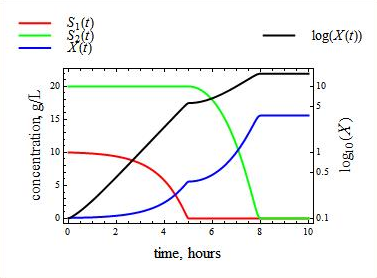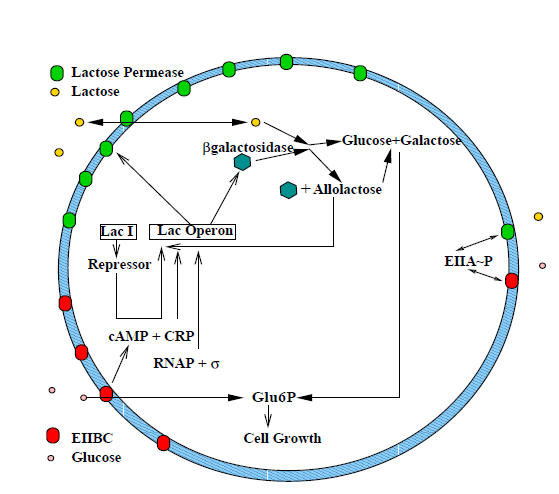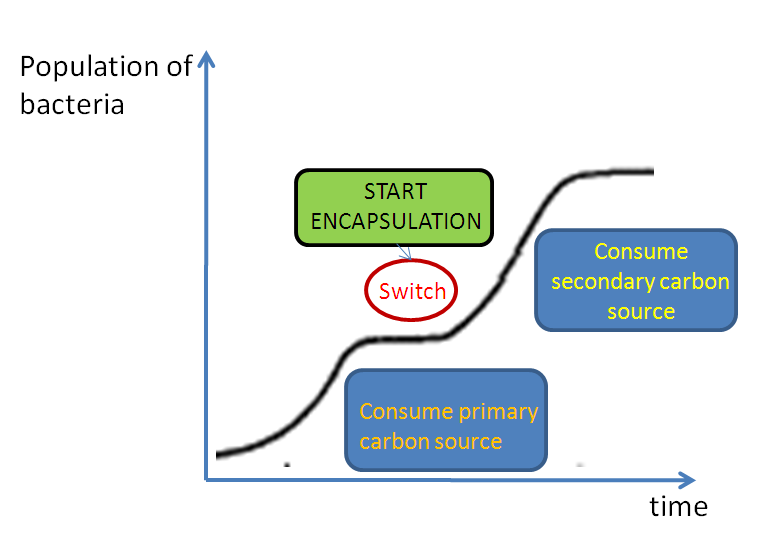Team:Imperial College London/Drylab/Autoinduction
From 2009.igem.org

Autoinduction
Starting the encapsulation process is related to diauxic growth of bacteria under the presence of two carbon sources. 2 models from literature have been discussed and implemented in this section. More information about each can be found in the extra tabs. After analysis of the models, we picked one of them as the best representation for our data. The sections below will provide a summary about each model, and at the end, discuss which one was picked and why. The diauxic growth phenomenon is tricky to understand, and the models we have chosen illustrate different approaches that groups have taken to explain what happens when bacteria switch to feeding from a primary carbon source to a secondary carbon source.
Contents |
Goal of the models
- Provide understanding of the diauxic growth phenomenon
- Find out the time taken to consume glucose in the medium to characterize the CRP promoter.
- Quantify the switch point from glucose to a secondary carbon source.
- Understand which is the best secondary carbon source to power the system after glucose is used up.
Model 1: Kompala et al cybernetic model
- This is a cybernetic model developed by Kompala et al [1].
- It is based on Michaelis-Menten assumptions for substrate consumption.
- The substrates in this case are our carbon sources: glucose, maltose, xylose, galactose...
Rationale:
In a mixture of carbon sources, glucose is energetically more favorable to consume(more on this is discussed in the autoinduction section).
This model includes the effects of enzyme activation and inhibition, as well as competition for metabolism of sugars [1].
Figure 1 from [2]
The red and green lines represent the concentrations of glucose (S1) and a secondary substrate (S2). As we can see, S1 is used up before S2. During this phase, the population (X- blue trace) grows exponentially and saturates when S1 runs out. Once it runs out, there is a switch phase, followed by metabolism of a secondary carbon source and entering a second exponential growth phase.
 About Kompala's cybernetic model
About Kompala's cybernetic model
Model 2: Wong, Keasling et al model
- Models such as Zhao Lu et al [3] or Keasling et al [4] cover in more detail lactose transport into the cell and the dynamics of the lac operon.
- Zhao Lu et al takes into account several factors that are not included in Kompala's model, such as:
- The effects of catabolite repression and inducer exclusion [3-4]( see chemical induction for further explanation).
- The "lag effect" seen when we switch from glucose to a secondary source. In the case of lactose, this delay is caused by the production of permeases and b-galactosidase.
- The Zhao Lu et al model does not take into account receptor binding interactions such as:
- Interaction of the lac repressor protein and the sigma factor with RNA polymerase involved in transcription initiation.
- Binding of CRP-cAMP
- Operator interactions of the lac repressor and allolactose.
These are included in the Keasling model, and hence the reason why we have implemented it [4].
- For more details of the metabolic network of the lac operon:

Figure 2 from Zhao Lu et al [3]
In the autoinduction medium, we have developed experiments where we have used secondary carbon sources such as: xylose, galactose, mannose... (See autoinduction experiments). We restrained from using lactose because it also induces the protein production module before time, although the other secondary carbon sources are related to lactose in structure.Hence, we believe that the dynamics of the lac operon have an important part to play in the bacterial metabolism in the presence of two secondary carbon sources.
References
[1]Kompala, D.S., D. Ramkrishna and G.T. Tsao, "Cybernetic modeling of microbial growth on multiple substrates," Biotechnology and Bioengineering 26 :1272-1281 (1984).
[2] Wolfram: http://demonstrations.wolfram.com/DiauxicGrowthOfBacteriaOnTwoSubstrates
[3] Zhao Lu et al. "Dynamics of Glucose-Lactose Diauxic Growth in E.coli". arXiv:0708.1993v1 [q-bio.OT] 15 Aug 2007
[4] Wong, P. , Keasling et al. "Mathematical Model of the lac Operon: Inducer Exclusion, Catabolite Repression, and Diauxic Growth on Glucose and Lactose." Biotechnol. Prog. 1997, 13, 132-143




 "
"




